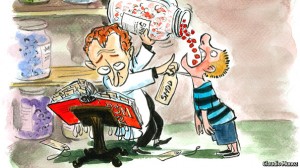The Economist
May 16, 2013
THE human brain is the most complex object in the known universe. It contains 100 billion nerve cells. Considering how complex that is, it goes wrong remarkably rarely.
But go wrong it sometimes does. Which is why, since 1952, the American Psychiatric Association has published its “Diagnostic and Statistical Manual of Mental Disorders”, the DSM. This book, the newest version of which will hit the shops on May 22nd (see article), contains the association’s thinking on what constitutes a disorder of the mind. It is consulted not only by psychiatrists, but also by insurance firms, drug companies and anxious patients and parents—not only in America, but around the world. It has become the industry standard for defining what is and is not a mental illness, and thus who gets treated, and who pays for treatment.
No other major branch of medicine has such a single text, with so much power over people’s lives. And that is worrying. Because in no other branch of medicine is the scientific reality underpinning the pronouncements of doctors so uncertain.
The categorical imperative
This uncertainty flows from a profound ignorance about how brains actually work. Neuroscientists understand how nerve cells work. They also know which bits of the brain deal with vision, locomotion, language, memory and suchlike. But between these two anatomical levels all is darkness. Psychiatrists have thus had to use behaviour patterns as proxies for underlying problems. And what constitutes a pattern is too often a matter of opinion rather than a statistically rigorous fact.
It is this desire to find and classify patterns which gives the DSM its power. By naming things it gives shape to the fledgling science. That is not a bad thing in principle. But in practice it has gone too far. The main criticisms are that it medicalises normal behaviour and that the strict categories of mental illness it creates are increasingly at odds with what research suggests is actually going on in the brain.
Read the rest of the article here


